I was scrolling through my news feed on LinkedIn the other day when I caught a post that caused me to chuckle.
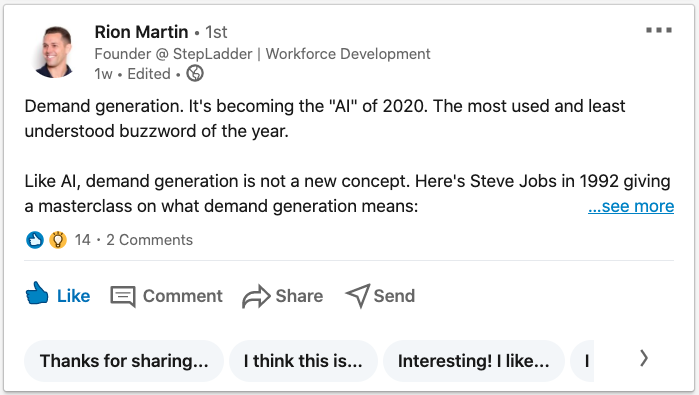
I didn’t realize that “Demand Generation” had become a buzzword; but if it had, I would have to agree with Rion that it probably is not well understood. And my next thought was “Great… now people are proclaiming that there’s an Easy Button for Demand Generation huh?”
As someone with a graduate degree in economics, additional post graduate work in applied economics and advanced quantitative methods, as well as a fair amount of experience building brands by creating demand through traditional and digital marketing channels spanning upper to lower funnel strategies and tactics, I had to ask myself – “OK, what am I missing here? When did this become a thing?”
A quick search on the almighty Google machine revealed that this really was an actual thing.
Google Trends shows that the search volume for “Demand Generation” is up 176% between March 15, 2020 and July 11, 2020 (impressive); and a Google search of the exact term “Demand Generation Software Industry” came back with 8,120 results.
OK, so I guess this is a thing. But what are people actually saying about Demand Generation and Demand Generation Software?
In a FinancesOnline.com article dated June 26, 2020, Demand Generation Software is described as follows:
“…helps marketing professionals to expand their reach to new markets, stimulate consumer interest, promote new products, create PR buzz, and re-engage existing customers. These solutions can be used for improving conversion optimization and sales cycles. They enable you to create consumer excitement about your product and offers useful tools to help you execute effective marketing strategies. The main purpose of demand generation software is to help marketers build and nurture lead and customer relationships over the long term. Key features of this system include lead generation, lead capture, lead mining, lead intelligence, lead scoring, and predictive analytics.”
WOW! That’s a ton of stuff!
They go on to provide their list of the top 12 demand generation software providers. I was familiar with all but one on their list; and in my opinion, they are generally traditional CRM, Campaign Management and Lead-to-Revenue Management technologies. And none of them will do everything FinancesOnline details in their definition.
Let’s unpack this Demand Generation thing a little more.
Unless you’ve been living under a rock for the past four months, it’s probably pretty obvious why there’s been a recent increase in interest in “Demand Generation.”
In economic terms, the Coronavirus crisis was an unforeseen exogenous shock (or structural break) that, for many businesses, temporarily (hopefully) wiped out 100% of the demand for their product and/or services (see figure below).
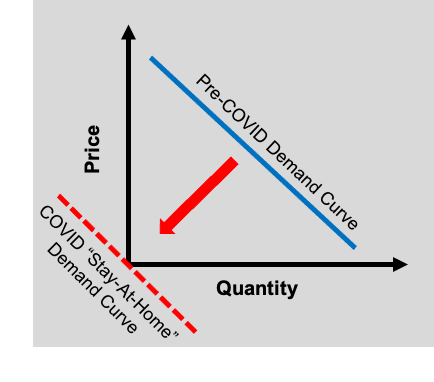
If you recall back to your Econ-101 days, demand is reflected as the relationship between price of a good or service, and quantity of that good or service consumed (solid blue line in the figure above).
Under “normal” circumstances, the higher the price the lower the quantity consumed and vice-versa. However, I think we can all agree that the last four months have been anything but normal; and for many businesses (i.e., Cruise Lines, Airlines, Car Rentals, Physicians performing elective procedures, Dine-in-only restaurants, Movie Theatres, Gyms, Live Sporting Events, Hair Salons, Concert Venues, Conferences, etc.) their demand curve effectively disappeared (reflected by the dashed blue line) as a result of the mass stay-at-home order, as well as individuals choosing to avoid risk. One could also argue that Supply was forcibly eliminated as well – leaving businesses unable to fulfill demand; but I’ll leave that for a future discussion…
Coming back to the topic of Demand Generation… Given everything that businesses have experienced over the past several months, it seems to reason that many organizations are thinking about ways to restore (generate) demand for their goods and services; and it’s highly likely some are even exploring this by using Google search.
But what exactly is “Demand Generation?”
According to my trusty old MIT Dictionary of Modern Economics, Demand is “The quantity of a good or service which an individual or group purchases at a ruling price.” It is important to note that in economic terms, demand requires a transaction – wants, desires, interest and consideration might be leading indicators (or precursors), but they are not demand.
And according to the Merriam-Webster dictionary, Generation is “The production of something.”
So to put it in a more straight-forward manner, Demand Generation is doing things to get people to buy the stuff you make or provide. But what are some of the “things” organizations can do to get people to buy (or buy more of) their stuff?
For decades, the decisions entrepreneurs made to generate business growth (getting people to buy more stuff) typically fell within in one or more of the four quadrants in the strategic growth framework illustrated below.
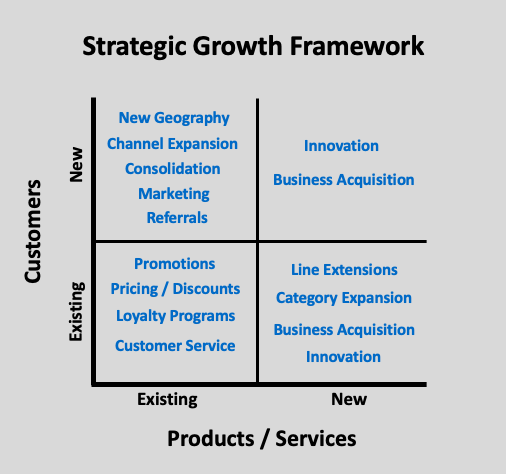
There have been thousands of books published on the various strategies or tactics noted in the quadrants above; but for context, let me provide some relatable examples from each quadrant.
1) Existing Customers / Existing Products
- Discounts for buying additional amounts or at certain times (e.g., buying in bulk, BOGO – Buy One Get One, or purchasing right before the end of a quarter)
- Additional benefits from being a part of a frequency or loyalty program (Baker’s Dozen – Buy 11 and the 12th one free, Points for every night’s stay, etc.)
2) New Customers / Existing Products
- Opening a new store in a new geography, adding salespeople in a new territory, opening an office in a different country
- Buying a direct competitor (which arguably also accomplishes the bullet immediately above)
- Getting into a new distribution channel (e.g., mailing catalogs to prospects, and/or getting into eCommerce)
3) Existing Customers / New Products
- Selling an insurance policy for something you are already selling (e.g., extended warranty for cars, appliances, etc.)
- Category expansion (Walmart / Target getting into the grocery & pharmacy business, Lawn Care business getting into the irrigation business, Nike getting into the apparel business, Amazon getting into cloud storage and computing, etc.)
- Business Acquisition (Coca-Cola buying Dasani and Vitamin Water)
4) New Customers / New Products
- Business Acquisition (Salesforce buying companies like Tableau, MuleSoft, Datorama, ExactTarget, Facebook buying Instagram, etc.)
- Innovation (Apple creating iTunes Music, iPhone, AppStore; etc.)
Each of the strategic approaches above are tried-and-true methods for generating additional demand – that is, increasing revenues or expanding a business. However, going back to the FinancesOnline definition for Demand Generation – “helps [organizations] to expand their reach to new markets, stimulate consumer interest, promote new products, create PR buzz, and re-engage existing customers” – in my opinion, what they are really talking about here is marketing and sales, the marketing and sales process, and tools (technologies) that can be utilized to make marketing and sales activities more effective and efficient.
The image below is a high-level depiction of the traditional brand / sales / purchase funnel – which is commonly understood to be a simplified illustration of the stages individuals may experience with a brand or an organization. Additionally, I’ve provided a partial list of marketing and sales tactics that can be utilized to create awareness, develop consideration (interest) and entice, persuade, or convince someone to purchase a good or service.
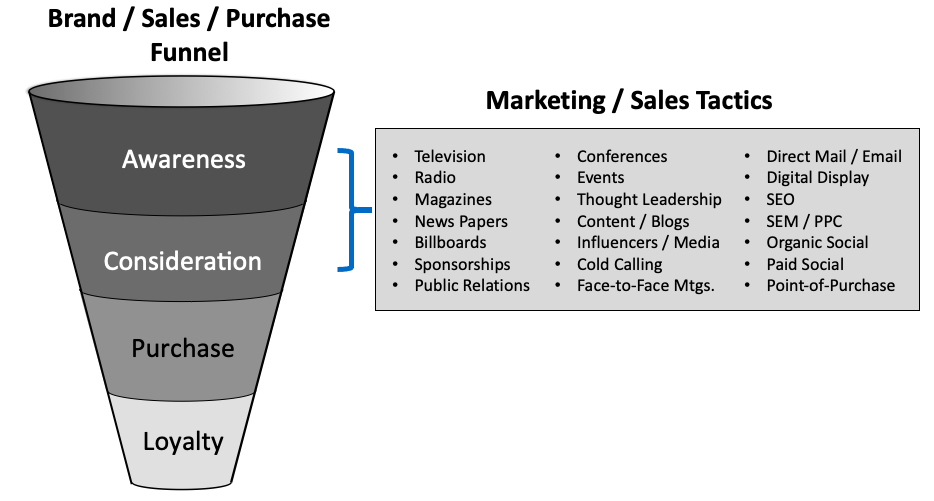
The goal of every business is to create value (for customers as well as for themselves) by providing goods and/or services that people want and need. And it has long been understood that in order to do this, you need to:
1) Make people Aware that you have the stuff they want and need.
2) Give those people (that you’ve made aware) a reason to Consider you over someone else who is providing the same or similar stuff.
3) Get them to Purchase your good and/or service.
4) Have them repeat their purchase (hopefully often) as a result of being highly satisfied with with your good and/or service.
That all seems pretty straight forward. But as we all know, this is anything but straight forward – or inexpensive.
Marketing and Advertising is big business
According to the Bureau of Labor Statistics (BLS), there are over a quarter million people in the US who are employed as “marketing managers” – which is defined as:
Plan, direct, or coordinate marketing policies and programs, such as determining the demand for products and services offered by a firm and its competitors, and identify potential customers. Develop pricing strategies with the goal of maximizing the firm’s profits or share of the market while ensuring the firm’s customers are satisfied. Oversee product development or monitor trends that indicate the need for new products and services.
And let me reassure you, there are WAY more than 250,000 people in the US who are involved in the practice of marketing.
PwC in its annual Global Entertainment and Media Outlook Report estimates that in the US alone, annual ad spend for just Online, TV, Radio and Magazine advertising is over $210 billion. And this doesn’t include the cost of making the ads, nor measuring their effectiveness.
According to eMarketer, annual spending on Marketing Technology is forecasted to be $122B by 2022. And if you’re familiar with Scott Brinker (editor of ChiefMarTech.com), you might be aware that the Marketing Technology Landscape now boasts over 8,000 “solutions!”
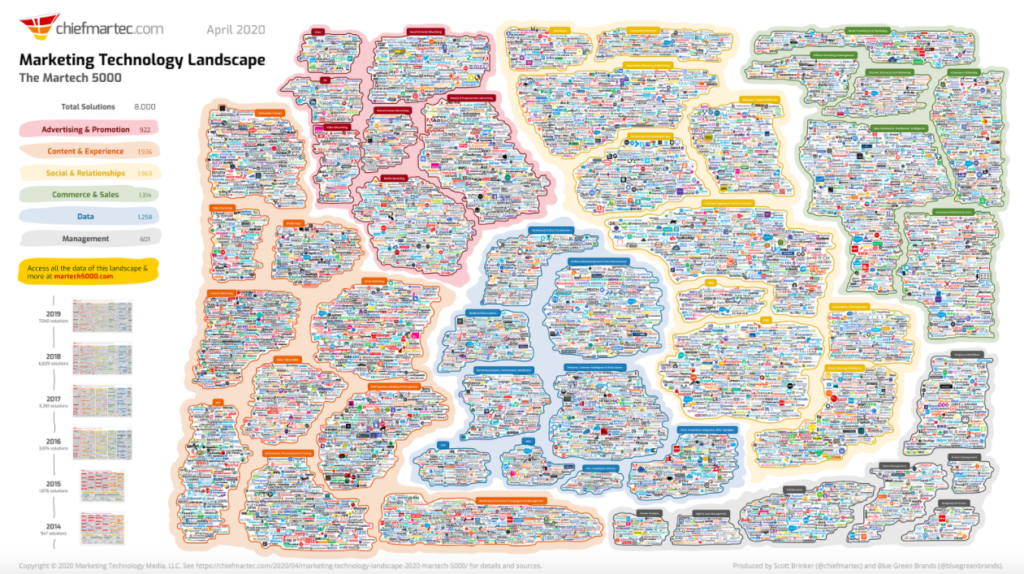
My point with all of this is this:
- Successfully building and growing a brand or business is hard work. It’s a team sport that has become much more difficult recently as a result of a once-in-a-lifetime pandemic. But it still requires that you deeply understand the wants and needs of your target customers, and that you thoughtfully leverage the right combination of Resources, Processes and Values in order to provide products and/or services that stand apart from your competition – and that your customers truly love.
- Everything you do, as well as everything everyone in your entire organization does each and every day plays a part in Generating Demand for your products and services.
- There is no such thing as an Easy Button or Silver Bullet for Generating Demand – that is, building and growing a brand or business.
- There is no single tool you can purchase that will provide an easy fix for restoring and increasing demand. But make no mistake, technology can be a strategic advantage for improving operating effectiveness/efficiency, as well as improving customer experience, engagement, and satisfaction.
So you want to know what Demand Generation really is? It’s called running a business that creates value as a result of an exchange that occurs between a supplier who is fulfilling the needs of a consumer, and an individual who purchases that good or service. And if I’m not mistaken, this isn’t a new thing either. Adam Smith actually wrote about this in 1776 in The Wealth of Nations.
Now, let’s get back to running our businesses, taking care of our customers, and actually generating more demand!
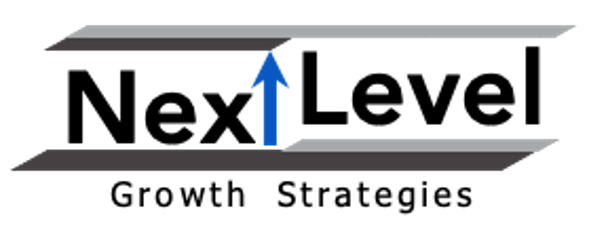

Leave a Reply